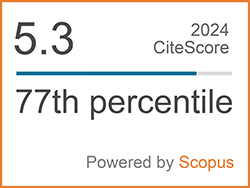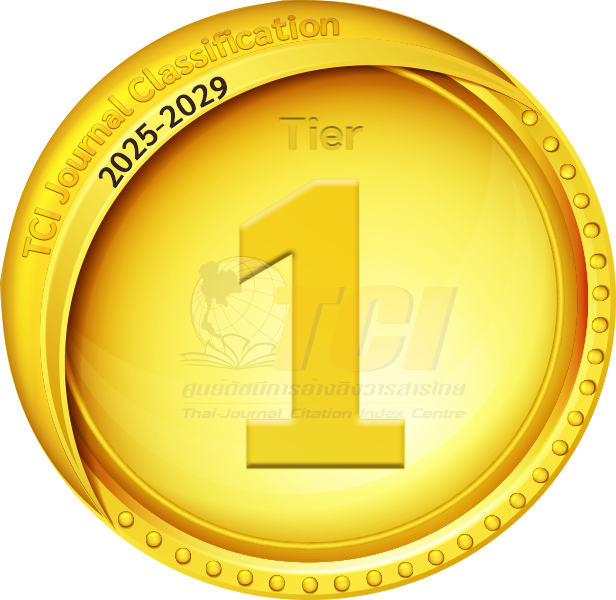Exploring Halophilic Bacteria Bacillus clausii Isolated from Madura Salt Pond: Challenges of Utilization in Hypersaline Microbial Fuel Cells for Fish Processing Wastewater Treatment
Abstract
Keywords
[1] H. T. H. Anh, E. Shahsavari, N. J. Bott, and A. S. Ball, “Options for improved treatment of saline wastewater from fish and shellfish processing,” Frontiers in Environmental Science, vol. 9, pp. 1–16, 2021.
[2] J. V. Boas, V. B. Oliveira, M. Simões, and A. M. Pinto, “Review on microbial fuel cells applications, developments and costs,” Journal of Environmental Management, vol. 307, pp. 1–19, 2022.
[3] K., Obileke, H. Onyeaka, E. L. Meyer, and N. Nwokolo, “Microbial fuel cells, a renewable energy technology for bio-electricity generation: A mini-review,” Electrochemistry Communications, vol. 125, pp. 1–14, 2021.
[4] M. Grattieri and S. D. Minteer, “Microbial fuel cells in saline and hypersaline environments: Advancements, challenges and future perspectives,” Bioelectrochemistry, vol. 120, pp. 127–137, 2018.
[5] I. M. Simeon, A. Weig, and R. Freitag, “Optimization of soil microbial fuel cell for sustainable bio-electricity production: combined effects of electrode material, electrode spacing, and substrate feeding frequency on power generation and microbial community diversity,” Biotechnology for Biofuels and Bioproducts, vol. 15, no. 124, pp. 1–19, 2022.
[6] F. Guo, H. Luo, Z. Shi, Y. Wu, and H. Liu, “Substrate salinity: a critical factor regulating the performance of microbial fuel cells, a review,” Science of The Total Environment, vol. 763, pp. 1–16, 2021.
[7] S. J. Robertson, M. Grattieri, J. Behring, M. Bestetti, and S. D. Minteer, “Transitioning from batch to flow hypersaline microbial fuel cells,” Electrochimica Acta, vol. 317, pp. 494–501, 2019.
[8] M. T. Jamal and A. Pugazhendi, “Treatment of fish market wastewater and energy production using halophiles in air cathode microbial fuel cell,” Journal of Environmental Management, vol. 292, pp. 1–7, 2021.
[9] B. Zhang and Z. He, “Improving water desalination by hydraulically coupling an osmotic microbial fuel cell with a microbial desalination cell,” Journal of Membrane Science, vol. 441, pp. 18–24, 2013.
[10] J. Qiu, R. Han, and C. Wang, “Microbial halophilic lipases: A review,” Journal of Basic Microbiology, vol. 61, no. 7, pp. 594–602, 2021.
[11] A. Pugazhendi, G. G. Alreeshi, M. T. Jamal, T. Karuppiah, and R. B. Jeyakumar, “Bioenergy production and treatment of aquaculture wastewater using saline anode microbial fuel cell under saline condition,” Environmental Technology & Innovation, vol. 21, pp. 1–9, 2021.
[12] W. Liu and Y. Wu, “Simultaneous nitrification, denitrification and electricity recovery of halomonas strains in single chamber microbial fuel cells for seawater sewage treatment,” Journal of Environmental Chemical Engineering, vol. 9, no. 6, pp. 1–8, 2021.
[13] R. E. A. Ghorab, A. Pugazhendi, M. T. Jamal, R. B. Jeyakumar, J. J. Godon, and D. K. Mathew, “Tannery wastewater treatment coupled with bioenergy production in upflow microbial fuel cell under saline condition,” Environmental Research, vol. 212, pp. 1–7, 2022.
[14] R. Gurav, S. K. Bhatia, T. R. Choi, H. R. Jung, S. Y. Yang, H. S. Song, Y. L. Park, Y. H. Han, J. Y. Park, Y. G. Kim, K. Y. Choi and Y. H. Yang, “Chitin biomass powered microbial fuel cell for electricity production using halophilic bacillus circulans bbl03 isolated from sea salt harvesting area,” Bioelectrochemistry, vol. 130, pp. 1–8, 2019.
[15] O. Monzon, Y. Yang, Q. Li, and P. J. Alvarez, “Quorum sensing autoinducers enhance biofilm formation and power production in a hypersaline microbial fuel cell,” Biochemical Engineering Journal, vol. 109, pp. 222–227, 2016.
[16] E. Ghelardi, A. T. Abreu y Abreu, C. B. Marzet, G. Álvarez Calatayud, M. Perez III, and A. P. Moschione Castro, “Current progress and future perspectives on the use of Bacillus clausii,” Microorganisms, vol. 10, no. 6, pp. 1–16, 2022.
[17] L. Muschallik, D. Molinnus, J. Bongaerts, M. Pohl, T. Wagner, M. J. Schöning, P. Siegert, and T. Selmer, “(r, r)-butane-2, 3-diol dehydrogenase from b. clausii dsm 8716t, cloning and expression of the bdhA-gene, and initial characterization of enzyme,” Journal of Biotechnology, vol. 258, pp. 41–50, 2017.
[18] G. D. Arum, M. Asy'ari, and N. S. Mulyani, “Effect of storage of yellow pigment from Halophilic Bacillus clausii J1G-0%B on antioxidant activity,” Jurnal Kimia Sains dan Aplikasi, vol. 25, no. 11, pp. 399–404, 2022.
[19] M. Christwardana, D. Frattini, G. Accardo, S. P. Yoon, and Y. Kwon, “Early-stage performance evaluation of flowing microbial fuel cells using chemically treated carbon felt and yeast biocatalyst,” Applied Energy, vol. 222, pp. 369–382, 2018.
[20] M. Christwardana, D. Frattini, G. Accardo, S. P. Yoon, and Y. Kwon, “Effects of methylene blue and methyl red mediators on performance of yeast based microbial fuel cells adopting polyethylenimine coated carbon felt as anode,” Journal of Power Sources, vol. 396, pp. 1–11, 2018.
[21] M. Christwardana, D. Frattini, G. Accardo, S. P. Yoon, and Y. Kwon, “Optimization of glucose concentration and glucose/yeast ratio in yeast microbial fuel cell using response surface methodology approach,” Journal of Power Sources, vol. 402, pp. 402–412, 2018.
[22] M. Christwardana, J. Joelianingsih, and L. A. Yoshi, “A novel of 2d-3d combination carbon electrode to improve yeast microbial fuel cell performance,” Journal of Applied Electrochemistry, vol. 52, pp. 801–812, 2022.
[23] M. Christwardana, J. Joelianingsih, L. A. Yoshi, and H. Hadiyanto, “Binderless carbon nanotube/carbon felt anode to improve yeast microbial fuel cell performance,” Current Research in Green and Sustainable Chemistry, vol. 5, pp. 1–11, 2022.
[24] Y. H. Chen, C. W. Lu, Y. T. Shyu, and S. S. Lin, “Revealing the saline adaptation strategies of the halophilic bacterium halomonas beimenensis through high-throughput omics and transposon mutagenesis approaches,” Scientific Reports, vol. 7, pp. 1–15, 2017.
[25] C. Kumawat, A. Kumar, J. Parshad, S. S. Sharma, A. Patra, P. Dogra, G. K. Yadav, S. K. Dadhich, R. Verma and G. L. Kumawat, “Microbial diversity and adaptation under salt-affected soils: A review,” Sustainability, vol. 14, no. 15, pp. 1–24, 2022.
[26] A. Vijay, P. C. Ghosh, and S. Mukherji, “Power generation by halophilic bacteria and assessment of the effect of salinity on performance of a denitrifying microbial fuel cell,” Energies, vol. 16, no. 2, pp. 1–16, 2023.
[27] M. Hemalatha, J. S. Sravan, and S. V. Mohan, “Self-induced bioelectro-potential influence on sulfate removal and desalination in microbial fuel cell,” Bioresource Technology, vol. 309, pp. 1–9, 2020.
[28] F. Orhan, “Potential of halophilic/halotolerant bacteria in enhancing plant growth under salt stress,” Current Microbiology, vol. 78, pp. 3708–3719, 2021.
[29] I. P. Guynn, K. Beaver, E. M. Gaffney, A. B. Zani, A. Dantanarayana, and S. D. Minteer, “salinivibrio sp. eagsl as a halophilic and ectoine-producing bacteria for broad microbial electrochemistry applications,” Cell Reports Physical Science, vol. 4, no. 6, pp. 1–11, 2023.
[30] J. F. Rusling and S. L. Suib, “Characterizing materials with cyclic voltammetry,” Advanced Materials, vol. 6, no. 12, pp. 922–930, 1994.
[31] M. Yang, Y. Zhong, J. Ren, X. Zhou, J. Wei, and Z. Zhou, “Fabrication of high‐power Li‐ion hybrid supercapacitors by enhancing the exterior surface charge storage,” Advanced Energy Materials, vol. 5, no. 17, pp. 1–7, 2015.
[32] S. Sevda, K. Chayambuka, T. R. Sreekrishnan, D. Pant, and X. Dominguez-Benetton, “A comprehensive impedance journey to continuous microbial fuel cells,” Bioelectrochemistry, vol. 106, pp. 159–166, 2015.
[33] K. Kim, D. Hwang, S. Kim, S. O. Park, H. Cha, Y. S. Lee, J. Cho, S. K. Kwak and N. S. Choi, “Cyclic aminosilane‐based additive ensuring stable electrode–electrolyte interfaces in Li‐ion batteries,” Advanced Energy Materials, vol. 10, no. 15, pp. 1–12, 2020.
[34] E. Laviron, “General expression of the linear potential sweep voltammogram in the case of diffusionless electrochemical systems,” Journal of Electroanalytical Chemistry and Interfacial Electrochemistry, vol. 101, no. 1, pp. 19–28, 1979.
[35] X. W. Liu, Y. X. Huang, X. F. Sun, G. P. Sheng, F. Zhao, S. G. Wang, and H. Q. Yu, “Conductive carbon nanotube hydrogel as a bioanode for enhanced microbial electrocatalysis,” ACS Applied Materials & Interfaces, vol. 6, no. 11, pp. 8158–8164, 2014.
[36] M. Shabani, M. Pontié, H. Younesi, M. Nacef, A. Rahimpour, M. Rahimnejad, and R. M. Bouchenak Khelladi, “Biodegradation of acetaminophen and its main by-product 4-aminophenol by trichoderma harzianum versus mixed biofilm of trichoderma harzianum/ pseudomonas fluorescens in a fungal microbial fuel cell,” Journal of Applied Electrochemistry, vol. 51, pp. 581–596, 2021.
[37] L. Huang, X. Zhang, D. Shen, N. Li, Z. Ge, Y. Zhou, M. Zhou, H. Feng and K. Guo, “Effect of heat-treatment atmosphere on the current generation of TiO2 nanotube array electrodes in microbial fuel cells,” Electrochimica Acta, vol. 257, pp. 203–209, 2017.
[38] Y. Wang, Q. Wen, Y. Chen, and W. Li, “Conductive polypyrrole-carboxymethyl cellulose- titanium nitride/carbon brush hydrogels as bioanodes for enhanced energy output in microbial fuel cells,” Energy, vol. 204, pp. 1–12, 2020.
[39] Y. Chen, Z. Zhao, S. Li, B. Li, Z. Weng, Y. Fang, W. Lei, and H. Jiang, “Fabrication of 3D graphene anode for improving performance of miniaturized microbial fuel cells,” 3 Biotech, vol. 12, pp. 1–10, 2022.
[40] M. Asghary, J. B. Raoof, M. Rahimnejad, and R. Ojani, “Microbial fuel cell-based self-powered biosensing platform for determination of ketamine as an anesthesia drug in clinical serum samples,” Journal of the Iranian Chemical Society, vol. 15, pp. 445–453, 2018.
[41] T. Christiansen and J. Nielsen, “Growth energetics of an alkaline serine protease-producing strain of b. clausii during continuous cultivation,” Bioprocess and Biosystems Engineering. vol. 24, pp. 329–339, 2002.
[42] A. K. Prabowo, A. P. Tiarasukma, M. Christwardana, and D. Ariyanti, “Microbial fuel cells for simultaneous electricity generation and organic degradation from slaughterhouse wastewater,” International Journal of Renewable Energy Development, vol. 5, no. 2, pp. 107–112, 2016.
[43] F. Xing, H. Xi, Y. Yu, and Y. Zhou, “Anode biofilm influence on the toxic response of microbial fuel cells under different operating conditions,” Science of The Total Environment, vol. 775, pp. 1–8, 2021.
[44] P. Xu, E. Xiao, L. Zeng, F. He, and Z. Wu, “Enhanced degradation of pyrene and phenanthrene in sediments through synergistic interactions between microbial fuel cells and submerged macrophyte vallisneria spiralis,” Journal of Soils and Sediments, vol. 19, pp. 2634–2649, 2019.
[45] R. Karthikeyan, A. Selvam, K. Y. Cheng, and J. W. C. Wong, “Influence of ionic conductivity in bioelectricity production from saline domestic sewage sludge in microbial fuel cells,” Bioresource Technology, vol. 200, pp. 845–852, 2016.
[46] A. Vijay, S. Arora, S. Gupta, and M. Chhabra, “Halophilic starch degrading bacteria isolated from sambhar lake, India, as potential anode catalyst in microbial fuel cell: A promising process for saline water treatment,” Bioresource Technology, vol. 256, pp. 391–398, 2018.
[47] R. Gurav, S. K. Bhatia, T. R. Choi, H. R. Jung, S. Y. Yang, H. S. Song, Y. L. Park, Y. H. Han, J. Y. Park, Y. G. Kim, K. Y. Choi, and Y. H. Yang, “Chitin biomass powered microbial fuel cell for electricity production using halophilic bacillus circulans bbl03 isolated from sea salt harvesting area, Bioelectrochemistry, vol. 130, pp. 1–8, 2019.
[48] B. R. Sreelekshmy, R. Basheer, and S. M. A. Shibli, “Exploration of bifurcated electron transfer mechanism in bacillus cereus for enhanced power generation in double-chambered microbial fuel cells,” Journal of Environmental Chemical Engineering, vol. 10, no. 3, pp. 1–13 2022.
[49] V. R. Nimje, C. Y. Chen, C. C. Chen, J. S. Jean, A. S. Reddy, C. W. Fan, K. Y. Pan, H. T. Liu, and J. L. Chen, “Stable and high energy generation by a strain of bacillus subtilis in a microbial fuel cell,” Journal of Power Sources, vol. 190, no. 2, pp. 258–263, 2009.
[50] A. Dongre, R. K. Sharma, M. Sogani, and N. K. Poddar, “Ultrasonic pre-treatment of bacillus velezensis for improved electrogenic response in a single chambered microbial fuel cell,” 3 Biotech, vol. 12, pp. 1–12, 2022.
[51] Y. C. Yong, Z. H. Liao, J. Z. Sun, T. Zheng, R. R. Jiang, and H. Song, “Enhancement of coulombic efficiency and salt tolerance in microbial fuel cells by graphite/alginate granules immobilization of shewanella oneidensis mr-1,” Process Biochemistry, vol. 48, no. 12, pp. 1947–1951, 2013.
[52] P. Srimuk, X. Su, J. Yoon, D. Aurbach, and V. Presser, “Charge-transfer materials for electrochemical water desalination, ion separation and the recovery of elements,” Nature Reviews Materials, vol. 5, pp. 517–538, 2020.
[53] J. Wang, Y. Liu, Y. Ma, X. Wang, B. Zhang, G. Zhang, A. Bahadur, T. Chen, G. Liu, W. Zhang, and Y. Zhao, “Research progress regarding the role of halophilic and halotolerant microorganisms in the eco-environmental sustainability and conservation,” Journal of Cleaner Production, vol. 418, pp. 1–13, 2023.
[54] F. Wu, W. Li, L. Chen, Y. Su, L. Bao, W. Bao, Z. Yang, J. Wang, Y. Lu and S. Chen, “Renovating the electrode-electrolyte interphase for layered lithium-& manganese-rich oxides,” Energy Storage Materials, vol. 28, pp. 383–392, 2020.
[55] B. Kim, I. S. Chang, R. M. Dinsdale, and A. J. Guwy, “Accurate measurement of internal resistance in microbial fuel cells by improved scanning electrochemical impedance spectroscopy,” Electrochimica Acta, vol. 366, pp. 1–30, 2021.
[56] T. Liu, Y. Y. Yu, D. Li, H. Song, X. Yan, and W. N. Chen, “The effect of external resistance on biofilm formation and internal resistance in shewanella inoculated microbial fuel cells,” RSC Advances. vol. 6, no. 24, pp. 1–19, 2016.
[57] T. Cai, Y. Zhang, N. Wang, Z. Zhang, X. Lu, and G. Zhen, “Electrochemically active microorganisms sense charge transfer resistance for regulating biofilm electroactivity, spatio-temporal distribution, and catabolic pathway,” Chemical Engineering Journal, vol. 442, pp. 1–12, 2022.
[58] M. T. Jamal, A. Pugazhendi, and R. B. Jeyakumar, “Application of halophiles in air cathode MFC for seafood industrial wastewater treatment and energy production under high saline condition,” Environmental Technology & Innovation, vol. 20, pp. 1–11, 2020.
[59] O. Monzon, Y. Yang, J. Kim, A. Heldenbrand, Q. Li, and P. J. Alvarez, “Microbial fuel cell fed by barnett shale produced water: power production by hypersaline autochthonous bacteria and coupling to a desalination unit,” Biochemical Engineering Journal, vol. 117, pp. 87–91, 2017.
[60] A. Pugazhendi, M. T. Jamal, B. A. Al-Mur, and R. B. Jeyakumar, “Bioaugmentation of electrogenic halophiles in the treatment of pharmaceutical industrial wastewater and energy production in microbial fuel cell under saline condition,” Chemosphere, vol. 288, pp. 1–9, 2022.
[61] M. Grattieri, M. Suvira, K. Hasan, and S. D. Minteer, “Halotolerant extremophile bacteria from the great salt lake for recycling pollutants in microbial fuel cells, Journal of Power Sources, vol. 356, pp. 310–318, 2017.
[62] M. Christwardana, G. E. Timuda, N. Darsono, H. Widodo, K. Kurniawan, and D. S. Khaerudini, “Fabrication of a polyvinyl alcohol-bentonite composite coated on a carbon felt anode for improving yeast microbial fuel cell performance,” Journal of Power Sources, vol. 555, pp. 1–9, 2023.
[63] A. Mishra and M. Chhabra, “Performance of photo-microbial fuel cell with Dunaliella salina at the saline cathode,” Bioresource Technology Reports, vol. 19, pp. 1–8, 2022.
[64] M. Puhm, H. Ainelo, M. Kivisaar, and R. Teras, “Tryptone in growth media enhances pseudomonas putida biofilm,” Microorganisms, vol. 10, no. 3, pp. 1–19, 2022.
[65] T. Teraishi, H. Hori, D. Sasayama, J. Matsuo, S. Ogawa, M. Ota, K. Hattori, M. Kajiwara, T. Higuchi, and H. Kunugi “13c-tryptophan breath test detects increased catabolic turnover of tryptophan along the kynurenine pathway in patients with major depressive disorder,” Scientific Reports, vol. 5, pp. 1–10, 2015.
[66] E. A. C. Hababag, A. Cauilan, D. Quintero, and D. Bermudes, “Tryptophanase expressed by salmonella halts breast cancer cell growth in vitro and inhibits production of immunosuppressive kynurenine,” Microorganisms, vol. 11, no. 5, pp. 1–14, 2023.
[67] A. P. Jiménez-Uribe, E. Y. Hernández-Cruz, K. J. Ramírez-Magaña, and J. Pedraza-Chaverri, “Involvement of tricarboxylic acid cycle metabolites in kidney diseases,” Biomolecules, vol. 11, no. 9, pp. 1–20, 2021.
DOI: 10.14416/j.asep.2025.01.003
Refbacks
- There are currently no refbacks.
 Applied Science and Engineering Progress
Applied Science and Engineering Progress







